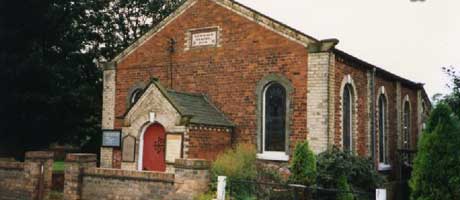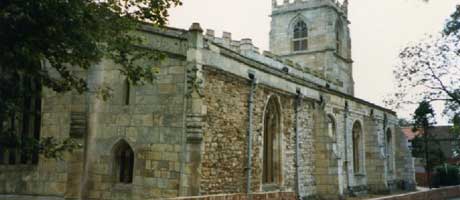Althorpe (Aletorp)
The parish of Althorpe and Keadby is situated on the west bank of the River Trent on the A18 Doncaster to Scunthorpe road, at the point where the A18 crosses the river via the Keadby road and rail bridge. This point is approximately six miles east of Crowle and four miles west of Scunthorpe. Keadby village is also situated on the Keadby-Stainforth canal built 1782, and in former times was a very important centre in the northern part of the Isle of Axholme, capable of providing a railway link to the main railway network, canal facilities to the marketing and industrial towns of the Midlands and also port facilities to connect Keadby with Hull and sea-going shipping.
The parish is one of the twelve parishes forming the Isle of Axholme, and part of the Boothferry District, which is now in the County of Humberside, formerly Lindsey, Lincolnshire. The ecclesiastical district is the Isle of Axholme Rural Deanery of Stow in the Diocese of Lincoln.
During an open weekend staged at St. Oswald's Church, Althorpe, in August 1989, many items of interest were on loan from various sources, one of which was a map from the Scunthorpe Museum and Art Gallery, produced for the Overseers of the Poor of Scunthorpe. The survey date was 1888 reprint 25/99. This particular map unfortunately only includes part of Althorpe parish. This map, however, clearly indicates the two separate civil parishes with the parish boundary alongside an unnamed open drain or stream with its outfall into the River Trent, immediately south of the old Keadby mill. The mill was sited on land adjacent to the Trent bank approximately where 'Mill House' now stands. This map clearly indicates the Public Elementary School huilt in 1876 which served both villages. (Now replaced by a modern building officially opened 22nd July 1975).
The Friendship Terrace is opposite the school and Hollywell Villa is also shown. The first Althorpe Station and level crossing does not appear on the map. However, this was sited south of the present line and bridge. The house which belonged to the Stationmaster and Crossing Keeper still stands today on the right of the A18 south of the railway bridge.
Keadby village is situated almost entirely on the north side of the canal, the exception is the Friendship Public House and two cottages between the south soak drain and the canal. Immediately north of the canal bridge was a level crossing with access to the wharf on the Trent, houses and the South Yorkshire Hotel are shown in an area which has been described as Keadby market place. Between this point and the old warping drain and sluice on the northern boundary of the village was situated Keadby village. Within this area there was a Primitive Methodist Chapel on the Trent side and a Wesleyan Methodist Chapel and Temperance Hall in Chapel Lane. The topography clearly shows the existence of both woodland trees and orchard and the existence of a group of cottages situated on the Trent bank adjacent to the warping drain. Today only one house exists on this riverside plot.
The civil parish of Althorpe and Keadby including the hamlet of Derrythorpe was formed into a single parish in 1954, taking in the former parish boundary of each parish. The ecclesiastical parish has, however, undergone many changes. Currently the Rector of Althorpe and Keadby is also group parish priest to Amcotts, Garthorpe and Luddington. For many years Amcotts had a Rectory, now a private house, and Garthorpe and Luddington had a Vicarage with a resident incumbent.
Prior to 1850 when Amcotts built their own church, they had a chapel of ease and were part of Althorpe parish. Burringham too had a chapel of ease and an arrangement with Althorpe Church prior to building their own church in 1857. These two dates are of special significance for about this time both parishes began using their own church registers. Burringham however had a special geographical problem for this village is situated on the east bank of the Trent with no bridge to connect with the west bank. It was therefore necessary to use the ferry boat to bring wedding and funeral parties over to Althorpe Church. The burials then took place in Althorpe Churchyard.
In searching for the origin of place names of settlements in the area, a visit to Scunthorpe Museum library produced surprising results. There was more than a little disagreement on the subject. Both Althorpe and Keadby appear to be of Danish origin and there were spelling variations e.g. Aletorpe, Alethorpe and Altorpe and Keteby, Kedby, Kidbie and Kadby.
T.R.F. Eminson in his 'Place and River Names of the West Riding and Lindsey' gives the following explanation. Althorpe receives its name from the 'village at the river pool', the river being the Trent and the pool the lake and swamp area which in former times surrounded the village of Burringham and referred to in the llth century as Manelinde Lake, stretching from Burringham to the higher ground where Messingham stands! The Doomsday records the name Aletorp coming from Ay-le-Thorpe, Ale being Danish and Anglian occurring in Aleford now Alford, Lincolnshire and Alegate now Aldgate, London. According to Eminson, Keadby refers to the settlement at the mooring haven, and in the time of the Edwards in the 14th century, Keadby had a haven pool where along with West Stockwith and Barton-upon-Humber supplied both men and ships for the King's service.
Discovering the above mentioned book, the first edition of place names compiled by John K. Johnstone is open to question. J.K. Johnstone gives more credence to the thorpe element, thorpe meaning settlement or farmhouse and Ali being the owner's name, thus giving Alithorpe and later Althorpe. Keadby is a corruption of Hedeby and is made up from haeth, a heath or a moor and 'by', an abode, producing the abode by the heath referring to Keadby Common.
Today this parish and the surrounding district is predominantly involved with agricultural activities with no livestock, other than a single farmer breeding and fattening pigs. There are wharf facilities recently extended at Keadby and a small industrial storage complex serving both Keadby and Gunness wharves. There are fewer people employed within the parish than ever before in its history; those who are employed within the parish are in minor servicing establishments.
For many years large numbers of people were employed in work associated with the canal and the river and even more employment was generated with the expansion of the Keadby Junction together with the loco yard and associated cattlepens in the 19th century.
There was competition between the canal and railway networks but there were opportunities for expansion for both at a time when farm produce, coal, steel and later petroleum products were transported by water and rail. In addition passenger services were provided, sharing the accommodation with all manner of merchandise ranging from livestock to groceries, provisions and stationery products.
A disruption to this comparative security began following the depressive years of the 1920's when Scunthorpe was continuing to develop and the rail network was due for redevelopment, following the opening of the new road and rail bridge at Keadby in 1915. So it was that on 12th June 1932, the new Frodingham yard opened in Scunthorpe and on the very same day, the Keadby loco yard closed. The yard and wharf facilities remained for some time but engines for use in the yard had to be sent down from Frodingham, and this added insult to injury. As a result, many workers left the area to work in the steel industry.
The Rector of St. Oswald's Church, Althorpe, comments on many occasions in the Parish Magazine during the 30's, of the loss of Church members leaving the district for better living accommodation and higher wages. The eventual closing down of the railway function and the nationalisation of the canal system in 1948 was a further devastating blow to Keadby. Use of the canal did continue into the 1950's but overall tonnage began to fall and by the late 1960's as the demand for coal declined, boats on both river and canal were disappearing. By the end of the 1970's commercial traffic had ceased using the canal between Keadby and Bramworth.
The waterways and the people who worked the boats have always been surrounded by much romantic speculation but in reality the work was hard and sometimes highly dangerous. Some idea of the intense activity in the 1920's is contained in Harry Day's account as a 'tug broker' at Keadby. Harry Day had an office on the Keadby jetty and he speaks of fifty and more boats leaving the canal on the tide. He would get up at 3 a.m., wake the captains, who would then prepare to go through the lock ready for the tide. There would be three or four tugs on the Trent each towing eight keels in a V formation. These keels would then transfer to the canal and would rely on 'horse-marines' or sail to continue their journey on the canal. The tugs would then collect the keels for a return journey to Hull.
Eric Todd, a boatman on the canal, had much to say on the subject of 'horse-marines'. The custom appears to have been, whoever caught a keel's rope when it was thrown to the jetty was hired, and the 'marines' who stabled their horses by the 'Friendship Inn' in Keadby would tow the keel to its destination. The 'horse-marines' wore distinctive clothing which consisted of a black trilby hat, a muffler, corduroy trousers and waistcoat. They all carried a whip tucked into a massive leather belt.
The list of boats using the canal and their cargoes is long and fascinating. "Manley Pride' carried grain, 'Integrety', 'Goodwill', 'Annie Maud' and 'Brasso' carried coal, aggregate and sand. The steam keel 'Swift' carried Darley's beer from Thorne to Hull and was a market boat on the return journey, delivering all manner of goods for both farms and shops, calling at Keadby, Crowle, Medge Hall and Thorne.
Among those who worked on the boats and eventually saw their disappearance were Eric Bailey, Billy Guest, Eric Todd, George Trevethick, Charlie Lister, Herbert Moxon, John Pettinger and George Beckett to name but a few.
Towards the end of the 19th century when the Rev. Robert Charlton was the rector of the parish and William Cranidge was the tailor, parish clerk and post master, the parish had a population of 1028 as compared with a total population today of 1740. James Booth was the headmaster of the Board School and Fred Walker and Edmund Foster were station masters at the two stations. Keadby also had a gas works situated by the canal.
The annual feast for Althorpe was the end of July and for Keadby, the third weekend in May. In Keadby activities appear to have taken place in the Market Place and in Althorpe, in Dolphin Street, now Ferry Road, extending from the post office to the Trent bank. The chapels also had anniversary celebrations and teas. The church had an annual church fete on a week day commencing during the afternoon and continuing into the evening so that workers could join in later.
All these events were much criticised by the head teacher at the Board School. He complained that together with all occasional days holiday and the extended holiday for potato picking and other land work, there was no time left for educating the children. At this time there were four carpels in the parish, two in Keadby, one in Althorpe and one in Derrythorpe. The only one remaining today is in Althorpe, beautifully maintained, and used regularly for Sunday worship.
The parish church of Althorpe and Keadby is dedicated to St. Oswald and stands on a raised strip of land in a sharp bend of the river, surrounded by Althorpe village. This living is a Rectory with rectors dating from 1154. The church was extensively restored in the 15th century using reclaimed stone from a previous building while at the same time, a new chancel and tower were added in 1483, financed by Sir John Neville, Knight of Althorpe.
The present church consists of a nave, a chancel, north aisle and an area previously a chantry chapel. It is recorded by Stonehouse and Read that the furniture of this chapel was in a state of disrepair and is alleged to have been removed, repaired and placed in Messingham church during its restoration in the 18th century. There is also a south facing porch and a tower in three stages. The porch was rebuilt during the reign of Queen Anne (1702-1714) and prior to the present cement rendering was formerly brick and above the door was a plaque with the following inscription :-
WM GLEW FM
HULTON RICH I
WESTOBY & RL
FOUR Ch Wd
AD 1710
On the western face of the tower appear the arms of Sir John Neville, quartering those of Newmarch and Mowbray. On the south side of the tower is a heraldic panel and relief carving of a ram and a tun or barrel (reputed to be a rebus for the builder Lambton). The construction is mainly ashlar with a random stone nave and north aisle, the style follows the perpendicular popular in the 15th century. Further items of interest are the 15th century oak screen with the remains of the steps to the rood loft, and a fine brass, dating from 1355. There are three remarkable sedilia, richly carved, sited next to the piscina, set in the south wall of the chancel.
The old burial ground surrounding the church and the additional burial ground consecrated in 1856 and closed early in the 20th century, now stand bereft of all the fine monuments which were in abundance until both burial grounds were cleared and levelled in the 1960's; a time when this treatment was fashionable both in town and village. There are but a handful of headstones now remaining, either set against the boundary wall or used for paving, leading to the church. The new Althorpe and Keadby cemetery purchased May 16th 1892 and brought into use soon after this date is situated in Althorpe across the road from the parish church. The M.I. records and the registers which date from 1670, including Amcotts previous to 1836 and Burringham previous to the mid 19th century, and the Brace transcripts covering the period 1672-1812, are all available at the Lincolnshire Archives. The registers currently in use can be viewed by contacting the rector.
The parish has eight listed buildings or objects of historic interest. The parish church is a Grade I and the following are listed as Grade II. Keadby Lock dated 1793-1802; Keadby Bridge (King George V Bridge) opened in 1916; A Thackery drain syphon dated 1813; the sluice on the Folly Drain; the old Rectory built in 1840 by Rev. James Aspinall M.A.; a 17th century old hall or manor house and 'Grove House', an early 19th century farmhouse, now a residential home for the elderly. There are many other fine buildings in the parish, including the Methodist Chapel with its memorial windows to the Stephenson family, who lived at Lansdowne House previously; the Stephenson Memorial Hall standing next to the War Memorial to the men who died during the two world wars.
With all the changes in the 20th century much population movement has taken place and in recent years one such event took place with the advent of Keadby Power Station, which brought much needed employment to the area. Work commenced in January 1948 and the power station was officially opened on April 1st, 1952. During the peak of building activity 1200 men were employed. On completion 323 men were employed to operate the station, half of whom lived in the houses specially built for the work force in Keadby. This project was short lived and closed in the early 1970's when Drax Power Station was completed.
The trades and occupations associated with the parish in the late 19th century are much the same as any riverside village. However, they have all been lost with the passage of time. They were :-
- George Petch - Coal merchant, hay & straw dealer and beer house keeper.
- William Armatage - Ships Chandler.
- Thomas Coggan - Miller.
- Jas. Greory - Biscuit and bread maker.
- Mary Greory - Muffin and pikelet maker.
- Jas. Guest - Marr and block maker.
- William Sharpe - Principal coastal officer.
- Reuben Young - Bazaar owner and hawker.
Names which are in the parish today are Bates, Bramworth, Brookes, Cranidge, Dunderdale, Eggar, Glew, Popplewell, Smith and Stones.
Today the parish only provides basic every day requirements. People travel to Scunthorpe and Doncaster for more elaborate shopping.
In drawing this 'Know Your Parish' to a close, a quote from Rev. Jas. Aspinall completing his census return for religious worship of the parish church in 1857:
In Keadby we have a population of 602 and Althorpe has a population of 335. We maintain an average congregation of 141, but principally the parish is all small freeholders, so we have never been able to raise enough money to claim public help to build a school. Children's wages are so high that children leave school by the age of eight years, and can earn 6, 8 or 10 pence per day working on the land prior to leaving school. What hope do we have for their education or their future. The services alternate between Althorpe and Amcotts Chapel. In Althorpe Church there are 80 free sittings and 100 others.


